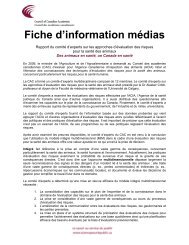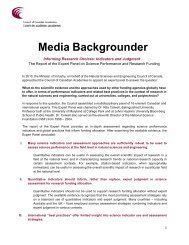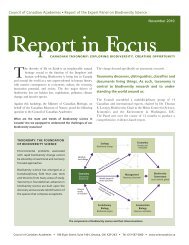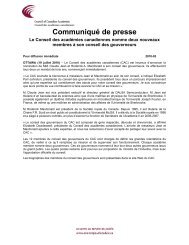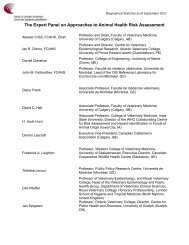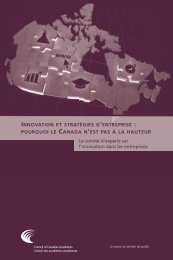an assessment of the evidence - Council of Canadian Academies
an assessment of the evidence - Council of Canadian Academies
an assessment of the evidence - Council of Canadian Academies
- No tags were found...
You also want an ePaper? Increase the reach of your titles
YUMPU automatically turns print PDFs into web optimized ePapers that Google loves.
Influenza Tr<strong>an</strong>smission <strong>an</strong>d <strong>the</strong> Role <strong>of</strong> PPRE: An Assessment <strong>of</strong> <strong>the</strong> Evidence 3Traditional infection control terminology has categorized influenza tr<strong>an</strong>smissionas occurring ei<strong>the</strong>r by “contact,” “droplet” or “airborne” modes. Since both droplet<strong>an</strong>d airborne tr<strong>an</strong>smission involve <strong>the</strong> inhalation <strong>of</strong> infectious particles into <strong>the</strong>respiratory tract, for <strong>the</strong> purpose <strong>of</strong> this report <strong>the</strong>se two modes have been groupedtoge<strong>the</strong>r under <strong>the</strong> term “inhalation tr<strong>an</strong>smission.”A person emits respiratory particles in a wide r<strong>an</strong>ge <strong>of</strong> sizes. Expelled particles c<strong>an</strong> becategorized into two groups depending on how <strong>the</strong>y travel – “ballistic” particles <strong>an</strong>d“inhalable” particles. Ballistic particles are those with a me<strong>an</strong> aerodynamic diametre<strong>of</strong> greater th<strong>an</strong> approximately 100 µm 1 <strong>an</strong>d are predomin<strong>an</strong>tly affected by gravity,as opposed to air resist<strong>an</strong>ce. Their infectious r<strong>an</strong>ge lies very close to <strong>the</strong> originalpoint <strong>of</strong> departure – generally less th<strong>an</strong> a metre. Inhalable particles are those withaerodynamic diametres falling approximately in <strong>the</strong> r<strong>an</strong>ge <strong>of</strong> 0.1 to 100 µm <strong>an</strong>d,depending on size <strong>an</strong>d shape, <strong>the</strong>y may remain in <strong>the</strong> air from seconds to days.Where particles are deposited in <strong>the</strong> respiratory tract <strong>of</strong> <strong>the</strong> potential host dependsprimarily on <strong>the</strong>ir size. Ballistic particles c<strong>an</strong> be deposited directly onto mucousmembr<strong>an</strong>es but have a low probability <strong>of</strong> being inhaled. The inhalable particlesc<strong>an</strong> be classified into three size categories that have different deposition behaviour.Nasopharyngeal-sized particles r<strong>an</strong>ge from approximately 20 to 100 µm in diametre<strong>an</strong>d tend to travel no fur<strong>the</strong>r th<strong>an</strong> <strong>the</strong> upper respiratory tract. Tracheobronchialsizedparticles have a diametre r<strong>an</strong>ging approximately from 10 to 20 µm <strong>an</strong>d arecapable <strong>of</strong> depositing as far down as <strong>the</strong> tracheobronchial region. Alveolar-sizedparticles are less th<strong>an</strong> approximately 10 µm in diametre. They are <strong>the</strong> only particlescapable <strong>of</strong> reaching <strong>the</strong> alveolar region but c<strong>an</strong> be deposited <strong>an</strong>ywhere in <strong>the</strong>respiratory tract.Long-r<strong>an</strong>ge <strong>an</strong>d Short-r<strong>an</strong>ge Tr<strong>an</strong>smission via Inhalation: There is accumulating<strong>evidence</strong> that, while <strong>the</strong> risk <strong>of</strong> acquisition <strong>of</strong> respiratory pathogens decreaseswith increasing dist<strong>an</strong>ce, tr<strong>an</strong>smission <strong>of</strong> infection across dist<strong>an</strong>ces <strong>of</strong> greater th<strong>an</strong>one metre may occur. The U.S. Centers for Disease Control <strong>an</strong>d Prevention (CDC)have recently reconsidered <strong>the</strong> traditional “short-r<strong>an</strong>ge” dist<strong>an</strong>ce benchmark (<strong>of</strong>tenreferred to as <strong>the</strong> “three-foot rule”) <strong>an</strong>d exp<strong>an</strong>ded it to two metres. In this report,short-r<strong>an</strong>ge tr<strong>an</strong>smission is defined as infection occurring within about two metres <strong>of</strong><strong>the</strong> source, <strong>an</strong>d long-r<strong>an</strong>ge tr<strong>an</strong>smission as infection at dist<strong>an</strong>ces greater th<strong>an</strong> abouttwo metres.The persistent survival <strong>of</strong> influenza virus in ambient air under common environmentalconditions suggests that long-r<strong>an</strong>ge inhalation tr<strong>an</strong>smission <strong>of</strong> influenza is1 A micrometer, also called a micron, denoted “µm”, is 10 -6 metre (m).





